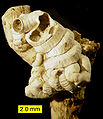
Tube worm
Encyclopedia

Sessility (zoology)
In zoology, sessility is a characteristic of animals which are not able to move about. They are usually permanently attached to a solid substrate of some kind, such as a part of a plant or dead tree trunk, a rock, or the hull of a ship in the case of barnacles. Corals lay down their own...
invertebrate
Invertebrate
An invertebrate is an animal without a backbone. The group includes 97% of all animal species – all animals except those in the chordate subphylum Vertebrata .Invertebrates form a paraphyletic group...
that anchors its tail to an underwater surface and secretes around its body a mineral tube, into which it can withdraw its entire body.
Tube worms are found among the following taxa
Taxon
|thumb|270px|[[African elephants]] form a widely-accepted taxon, the [[genus]] LoxodontaA taxon is a group of organisms, which a taxonomist adjudges to be a unit. Usually a taxon is given a name and a rank, although neither is a requirement...
:
- (The phylumPhylumIn biology, a phylum The term was coined by Georges Cuvier from Greek φῦλον phylon, "race, stock," related to φυλή phyle, "tribe, clan." is a taxonomic rank below kingdom and above class. "Phylum" is equivalent to the botanical term division....
) AnnelidAnnelidThe annelids , formally called Annelida , are a large phylum of segmented worms, with over 17,000 modern species including ragworms, earthworms and leeches...
a (a.k.a. segmented worms)- (The classClass (biology)In biological classification, class is* a taxonomic rank. Other well-known ranks are life, domain, kingdom, phylum, order, family, genus, and species, with class fitting between phylum and order...
) PolychaetePolychaeteThe Polychaeta or polychaetes are a class of annelid worms, generally marine. Each body segment has a pair of fleshy protrusions called parapodia that bear many bristles, called chaetae, which are made of chitin. Indeed, polychaetes are sometimes referred to as bristle worms. More than 10,000...
a (a.k.a. bristle worms)- (The orderOrder (biology)In scientific classification used in biology, the order is# a taxonomic rank used in the classification of organisms. Other well-known ranks are life, domain, kingdom, phylum, class, family, genus, and species, with order fitting in between class and family...
) CanalipalpataCanalipalpataCanalipalpata, also known as bristle-footed annelids or fan-head worms, is an order of polychaete worms, with 31 families in it including the Sabellida and the Alvinellidae, a family of deep-sea worms associated with hydrothermal vents.The Canalipalpata have no teeth or jaws. Most are filter feeders...
(a.k.a. bristle-footed annelids or fan-head worms)- (The familyFamily (biology)In biological classification, family is* a taxonomic rank. Other well-known ranks are life, domain, kingdom, phylum, class, order, genus, and species, with family fitting between order and genus. As for the other well-known ranks, there is the option of an immediately lower rank, indicated by the...
) SiboglinidaeSiboglinidaeSiboglinidae, also known as the beard worms, is a family of polychaete annelid worms whose members made up the former phyla Pogonophora and Vestimentifera. They are composed of about 100 species of vermiform creatures and live in thin tubes buried in sediments at ocean depths from 100 to 10,000 m...
(a.k.a. beard worms)- (The speciesSpeciesIn biology, a species is one of the basic units of biological classification and a taxonomic rank. A species is often defined as a group of organisms capable of interbreeding and producing fertile offspring. While in many cases this definition is adequate, more precise or differing measures are...
) Riftia pachyptila (a.k.a. giant tube wormGiant tube wormGiant tube worms, Riftia pachyptila, are marine invertebrates in the phylum Annelida related to tube worms commonly found in the intertidal and pelagic zones...
) - (The genusGenusIn biology, a genus is a low-level taxonomic rank used in the biological classification of living and fossil organisms, which is an example of definition by genus and differentia...
) LamellibrachiaLamellibrachiaLamellibrachia is a genus of tube worms related to the giant tube worm, Riftia pachyptila. It lives at deep-sea cold seeps where hydrocarbons are leaking out of the seafloor. It is entirely reliant on internal, sulfide-oxidizing bacterial symbionts for its nutrition.L...
- (The species
- (The family) SerpulidaeSerpulidaeSerpulidae is a family of sessile, tube-building annelid worms in the class Polychaeta. The members of this family differ from the sabellid tube worms in that they have a specialized operculum that blocks the entrance of their tubes when they withdraw into the tubes. In addition, serpulids secrete...
- (The family) SabellidaeSabellidaeSabellidae are sedentary marine polychaete tube worms where the head is mostly concealed by feathery branchiae. They build tubes out of parchment, sand, and bits of shell...
(a.k.a. feather duster worms)
- (The family
- (The order
- (The class
- The phylum PhoronidPhoronidPhoronids are a phylum of marine animals that filter-feed with a lophophore , and build upright tubes of chitin to support and protect their soft bodies. They live in all the oceans and seas including the Arctic Ocean but excluding the Antarctic Ocean, and between the intertidal zone and about...
a (a.k.a. horseshoe worms) - The order MicroconchidaMicroconchidaThe Order Microconchida is a group of small, spirally-coiled, encrusting fossil "worm" tubes found from the Upper Ordovician to the Middle Jurassic around the world . They have lamellar calcitic shells, usually with pseudopunctae or punctae and a bulb-like origin...
(extinct tubeworms)

